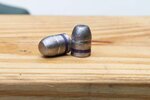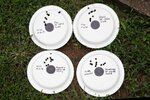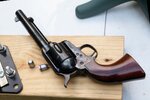Got a chance to test 3 different .45 Colt BP loads today. Early 90’s era Goex in 2F and 3F, and Schuetzen 3F. Most of this won’t be any surprise to aficionados. For me though, a couple interesting finds. Testing handgun was my Uberti Cattleman, 5-1/2" barrel.
Brass was new R-P. I also have new Win brass but length of R-P brass is much more consistent. With Win brass, about 15% or so are short and I would need to trim a batch up to get consistent bullet seating depth. There was almost no case length variation with R-P.
Primers were WLP, labeled “for use with standard or magnum loads”.
No drop tube. All charges funneled into the case, then a .030 vegetable wad, bullet seated to crimp groove and a firm roll crimp. Bullet was the Desperado Cowboy Action .452” 1:20 tin/lead with their lube described as “suitable for smokeless or black powder”.
View attachment 1172351
I used a scale to set my volume powder measure to throw 32 grains of each powder. Of note, the 90’s Goex needed a little more measure volume to reach 32 grains, a little less volume when measuring 32 grains Schuetzen.
Chronograph set 12 feet from muzzle, target set at 15 yards. 12 shots each powder, with 2 for fouling followed by 10 over the chronograph. After each set, fouling was removed from bore and chambers with Ballistol/water mix, then a dry patch. Also, I decided to throw in a set of Black Hills smokeless 250 gr cowboy loads for comparison. Results:
| Goex 2F (early 90's production)/32 gr | Goex 3F (early 90's production)/32 gr | Schuetzen 3F/32 gr | Black Hills 250 gr CB Factory |
High 704
Low 649
Avg 676
SD 13 | High 809
Low 756
Avg 774
SD 17 | High 665
Low 627
Avg 646
SD 12 | High 750
Low 695
Avg 725
SD 16 |
I don't know if the 10 shot, 15 yard groups (from rest) were me or the pistol, but when in doubt I always blame myself first until someone else shoots it. But it certainly looks consistent. POA was 6 o'clock on the black circle.
View attachment 1172352
On follow up, I didn't notice any of the crusty fouling with these powders I did with Swiss 2F. Both Goex powders impressed me with how quickly the bore cleaned up. I only needed a few patches to go from jet black to traces of light grey. There were a few unburned grains of Goex 2F but nothing crazy. There was also incompletely burned powder with the Black Hills smokeless factory ammo. There was no sign of unburned residue with either of the 3F grades.
Another observation is that cases were remarkably clean on the outside when ejected. With Swiss, I had significant outer case fouling residue. Not sure what to make of that. Those were loads generating over 800 fps so I would think I was getting good gas seal.
I also didn't notice the same velocity decline with these powders I did with Swiss. Schuetzen was very consistent from first shot to last, and the last shot in the string was exactly 2 fps faster than the first, an impressive result. I believe the lower velocity of Schuetzen is attributable to reducing the powder dispenser volume slightly to maintain the desired scale weight of 32 grains. Someone loading volume for volume may notice less difference, and the consistency of Schuetzen 3F puts it near the top of list of powders I've tried so far.
View attachment 1172357




